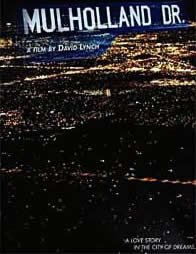
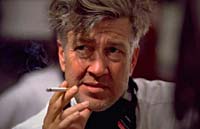
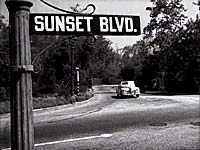
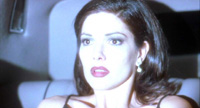

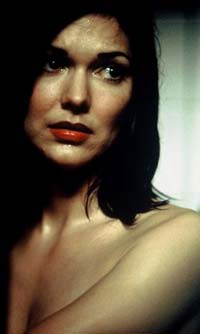
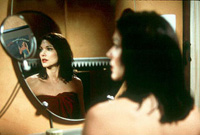
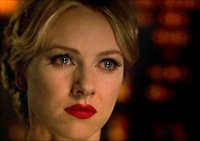
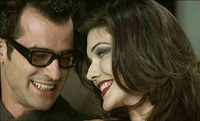
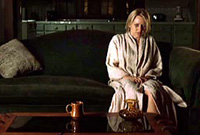
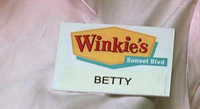
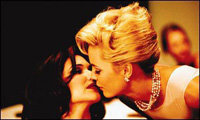
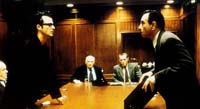
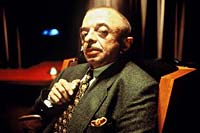
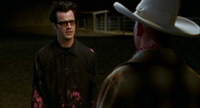
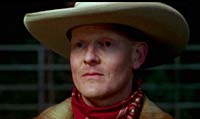
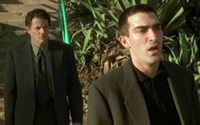
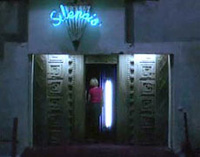

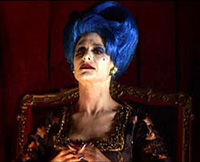
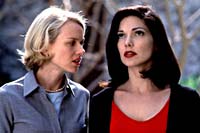
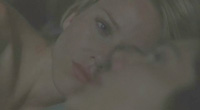
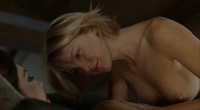
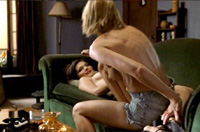
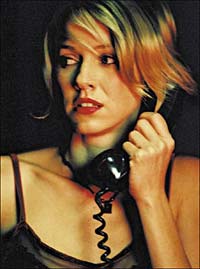
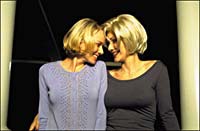
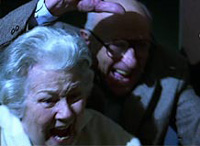
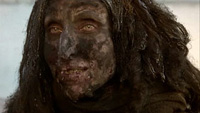
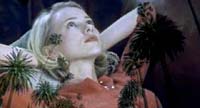
ALICE IN LOTUSLAND
From the Wreckage of Spoiled Dreams-Movie Magic
By Eddie Muller © 2001
Mulholland Drive is a triumph, both as a revelatory reimagining of traditional narrative cinema, and as personal vindication for its maker. Like a master magician, David Lynch has conjured a mature, evocative and emotionally satisfying experience from the wreckage of dispiriting failure. Critics are picking over the film like detectives combing a crime scene, sifting for the remains of the ill-fated television pilot that was its genesis, as if they suspect the finished work is a jerry-rigged parlor trick, rather than a fully-realized work of art. Lynch meanwhile remains a tight-lipped perpetrator, testifying only that his film is "A love story in the city of dreams."
No further explanation needed. For unlike other "Lynchian" projects, Mulholland Drive is not mystifyingly open-ended. Rather, it's scarily self-contained. It's a mystery, certainly, but by the time it reaches its crushing conclusion, it is specifically about one thing: the crumbling psyche of a young Hollywood dreamer. Trapped in a movie-inspired fever of desire and heartbreak, she's driven to commit murder. But Mulholland Drive is more than just a feminized version of Lynch's own Lost Highway. It's a worthy successor to such bleak Lotusland fables as Nathaniel West's Day of the Locust, Nicholas Ray's In a Lonely Place, and perhaps most significantly, Billy Wilder's Sunset Boulevard, of which it's a rabid offspring.
Early in the film, as a wounded woman numbly descends into the lights of Hollywood after surviving a car wreck on Mulholland Drive, Lynch inserts signposts to map the terrain, literally, and in the case of "Sunset Blvd.," figuratively. This tale, after all, will turn into a fin de siecle bookend to Wilder's mordant midcentury take on the movie business's power to insidiously shape reality, to delight and destroy in equal measure.
Both films depict naive wannabes in the thrall of vainglorious femmes fatales. Both revolve around a contest of wills, in which lovers battle for dominance. Both spend ample time lampooning the hubris in the Dream Factory's machinations, as well as showing its cruel disdain for the neurotic foot soldiers chewed up in the gears. Both films reveal the Promised Land's dreadful undertow, which sucks down the weak-willed and gullible. Both stories are narrated by one of these drowning losers.
(During the five-year course of making Eraserhead, Lynch would screen Sunset Boulevard for his crew whenever filming resumed, to remind them of the feel he wanted in his film.)
The thematic conventions and visual iconography of film noir play a part in both films. For a good bit of their running times, both are detective stories, in which the protagonist, swept into the orbit of an alluring woman, tries to solve her mysteries despite obvious warning signs. Fatefully, a needy, consuming relationship develops before the "truth" is revealed. Menacing figures of vague origin circle like buzzards, either gangsters in a malevolent conspiracy or someone's paranoid delusions. The affair goes bad when one lover cashes out her stake in the shared delusion. Bullets follow. Lynch even throws in a bout of amnesia, a venerable device dating back to such L.A.-based noir classics as Somewhere in the Night (a phrase that leaps to mind as Robert Forster, in his minuscule appearance, ponders the glittering expanse of Los Angeles).
All these elements, familiar from many works of far lesser stature than Sunset Boulevard, are useful iconographic guides for navigating the convoluted course of Mulholland Drive. It gives viewers some bearings as Lynch twists traditional narrative structure, spinning an old plot in a new way. There is clearly a beginning, middle and end to Mulholland Drive; Lynch just doesn't travel the route in that order.
Some viewers will opt out, resenting such obtuse storytelling. Others will be invigorated, even exhilarated. This type of gamesmanship demands intellectual and emotional investment from the spectator. The reward is a more engrossing and provocative experience than one normally encounters at the multiplex. It can be frustrating and enervating, but both are valid emotions in Lynchland. Predictability, boredom and ennui are not.
When you get down to it (or, more appropriately, open up to it), Lynchland isn't all that impenetrable—despite the befuddlement his films supposedly generate. They're created from recognizable elements, common settings viewed askew. Unlike the computer-generated sci-fi fantasy worlds that pass for "visionary" with the younger generation, Lynch isn't interested in fashioning an alternate reality into which the emotionally stunted can escape. He's burrowing into a world we all recognize and share, and it's a vision anyone can comprehend, with an open and willing mind. Far from obscure, Lynch seems generous, providing an experience with more layers of meaning, and avenues of access, than other filmmakers even contemplate.
[Read no further if you haven't seen the movie.]
The surface level of the story is, by the end, very clear: Diane Selwyn was a bright-eyed ingenue, eager for a movie career, who lost her big break to glamorous Camilla Rhodes. Generous Camilla not only offers Diane a bit part in "The Sylvia North Story," she offers a place in her bed as well. If Diane can't be a star, at least she can love one.
But when Camilla dumps her for director Adam Kecher—who lords it over the movieland minions from his mansion way up on Mulholland—poor Diane snaps. She gives a scummy hitman a purseful of money and a headshot of her former lover: "This is the girl," she instructs him. Diane then retreats to a miserable bungalow, to lie low and wallow in her misery.
On the last night of her life, she dreams this very story, but her subconscious shapes it into the movie she wishes it had been—an exciting tale of how spunky "Betty" rescued and fell in love with ravishing "Rita," who adored her in return. But the dream ends, and Diane is left with a dismal reality that's spun out of control. When the police track her down, knocking on the door, she blows her brains out to silence the roiling pain and guilt.
What makes the movie so challenging is that two-thirds of the narrative is Diane's dream, which you don't realize until she wakes up and—cue the plummeting elevator—you understand that "Betty" is only a figment of Diane's subconscious. She gleaned "Betty" from a waitress's badge at the diner where she hired the assassin. The last third of the film flashes back from Diane's final waking hours, cataloging the indignities, real and imagined, that drove her to have Camilla killed. The only scenes that take place in "real time" are those in which Diane shambles around in a dirty bathrobe, paralyzed by remorse.
It's a thrilling revision of traditional narrative: the exciting "climax" is the wave of expository information that makes us rethink all that's gone before.
Several plot threads clearly intended for the more expansive framework of a TV series end up filtered through Diane's consciousness, showing her paranoid vision of Hollywood, both old and new: a room full of freeze-dried studio hacks are floored by her stunning audition, but still rule thumbs-down; a casting meeting between the callow Kecher and his menacing financiers is covertly observed by Mr. Roque, the anonymous puppetmaster who parcels out the "breaks." In Diane's mind, they're all conspiring against her. Even a biddy psychic (faded thespian, no doubt) gives Betty/Diane a disdainful competitive sniff, upon learning she's an actress.
There's always a "Mr. Big" in David Lynch's films, an incarnation of the energy that controls the course of human events. Here it's "The Cowboy." His mystical corral exists on a plane even higher than the Hollywood sign. He's overseen this terrain since the cameras first arrived, since William S. Hart ushered in the cinema of sensation by pointing a six-shooter at the audience and firing. The Cowboy is an ambivalent figure, neither benevolent or malevolent. When he dresses down the "smart aleck" director, he's like a ghostly messenger from the founding Jesse Lasky Feature Player Company, emerging from Hollywood's original ranchland to read the rules, in no uncertain terms, to this self-important newcomer.
Also appearing, in a regular alleyway engagement behind Winkie's diner, is another member of the Lynch stock company: the Force of Evil. As a visual artist, Lynch has always been compelled to represent "evil" in a single human symbol, providing a locus for the ambient dread that floats through his frames. That he's introduced through a peripheral character—who promptly dies in the face-to-face encounter—is one of the film's loosest threads.
Since Diane is in both subsequent diner scenes, a possible interpretation is that she is the terrified dreamer, incognito, trying to explain her anxieties to an agent or therapist. It doesn't really matter. Intuitively and emotionally, Lynch's gamble pays off. The first scene establishes Winkie's as a place where horror lurks, effectively coloring two pivotal scenes to come. One can infer from subtle suggestions that Diane actually worked at the diner, another reverberation on the classic "fledgling starlet" story [all waitresses in L.A. are really actresses]. And it's Winkie's, after all, where Diane will cross into darkness, even after she's warned that "there's no going back."
Equally confounding is the 2 A.M. trip to Club Silencio, another familiar stop on the Lynchland tour: the red curtains, the all-knowing emcee, the sense of paralytic entrapment, the Orbison. It's all on display, again, but now it serves multiple purposes: It allows "Betty" and "Rita" to bond in a mystical way-which gives the rest of the movie its emotional weight. It also explains the emotional heart of the story, but in peculiarly Lynchian terms. By having Rebekah del Rio sing "Crying" in Spanish, the director opts for further mystifying a large percentage of his audience. Of course, for those who speak Spanish, or know the lyrics, the song clearly explains the Diane/Camilla relationship.
This scene also represents the dream coming to its climax. Betty (significantly not Rita) convulses in her seat as she begins to "come out" of it. In this case, "it" is not only her dream-state, but the unconscious realization that she's invested so much in a hoax. As the emcee explains, you can't trust your eyes in this "theater." The magic of synchronized sound and image—cinema—is wonderful and deceptive, but it is not reality. Diane's willful desire to live a fantasy is the crux of her demise.
In Mulholland Drive, Lynch not only conjures his patented dreamscape of sensuous and unsettling imagery, by the end he's assembled the instinctual and disconnected threads into a tight and painful Gordian knot. That's something he never quite managed with other fractured narratives such as Fire Walk with Me, Wild at Heart, or Lost Highway. Despite flashes of poetic brilliance, and a free-floating mix of apprehension and black humor, those films are frustratingly elliptical. At their worst they're freak shows, especially when they're crammed with hipsters savoring their inclusion in Lynch's carnival.
Lost Highway and Mulholland Drive will come to be seen as virtually inseperable works, yin-yang versions of the same premise—a dream-state excavation of a mind that's committed murder. But Lost Highway was a repellent, not seductive journey, and once Bill Pullman went missing, so did the emotional anchor required to pull the audience fully into the depths of Lynchland.
In Mulholland Drive, Lynch has a pair of anchors, costars Naomi Watts and Laura Elena Harring. Their onscreen freshness heightens the revelatory quality Lynch is after in every scene (of every movie he makes). Perhaps he'd realized that well-known players can be a distracting disaster, like Nicolas Cage mugging through Wild at Heart. Here, when Nancy Drew leads Rita Hayworth to hell (or vice versa), the devastation is deeply felt. The actresses deserve as much credit as Lynch for being able to embody, by turns, such appealing and awful energy.
Watts and Harring bring palpable passion to Diane and Camilla's slowly emerging relationship. It's no less real because it's a dream, and it's achieved not through scripted backstories or rational exposition, but solely through their physical interaction. The fact that it works—without words—is another triumph for a director notoriously suspicious of attaching literal explanations to his visceral obsessions.
In the past, Lynch has taken grief in politically-correct quarters for his treatment of women, and in some cases, such as the cruel handling of Laura Dern and Patricia Arquette (in Wild at Heart and Lost Highway, respectively) the films' foundations are too shaky to provide a valid defense for the lurid debasement—even if those scenes are at the heart of Lynch's artistic preoccupation: the constant threat that purity, innocence and beauty face from corrupt, malignant forces. Lynch clearly understands the immense power of women's bodies, and in Mulholland Drive he finally channels that energy in a respectful way—without sacrificing any of the sensuality he relishes. Rethinking the story from inside Diane's psyche might account for the difference.
On initial viewing, the love between Diane and Camilla unfolds in a sequence unique in its intensity, tenderness and sincerity—both for Lynch and American movies in general. Usually nude love scenes are cringe-inducing, plagued by a combination of hackneyed direction, cynical exploitation, and the sacrifice of storytelling momentum to ticket-selling titillation. In this instance, however, the moment is electric. The combination of Lynch's sensitive direction (he shows enough to be erotic, but stops short of voyeurism), cinematographer Peter Deming's gorgeous half-light, and the breathless, bona fide heat of Watts and Harring, conjures lightning in a bottle—it's a scene of compelling sexuality.
Their second love scene, by comparison, comes off stark and tawdry—which cuts to the core. One is a ravishing fantasy of blissful intimacy, the other a final midday fuck-off to a dalliance gone cold. When Watts later takes to the same couch, tearfully masturbating as she tries to reclaim an image of her dream lover, she's in a lonely place few movies dare to go. These sex scenes aren't only crucial to the plot—in Lynch's cinematic shorthand they are the plot, and Naomi Watts is fearless and mesmerizing in the way she defines, and deepens, Lynch's themes. Minus these scenes (if Mulholland Drive existed only as the ill-fated pilot), Watts' performance would have been devalued, even denigrated, for its (seemingly) simplistic star-crossed goofiness. In the finished version, she's pure revelation.
A second viewing shows that Diane's infatuation with Camilla exists all along, bubbling beneath her guileless facade: in virtually every scene the women are only a breath apart, touching each other, gazing into each others' eyes, acting unconsciously like illicit lovers. Since these scenes existed in the (pre-lesbian) pilot, it's hard not to believe that Lynch meant "
© All rights reserved. Reproduction of this article without the express written permission of the author is strictly prohibited.